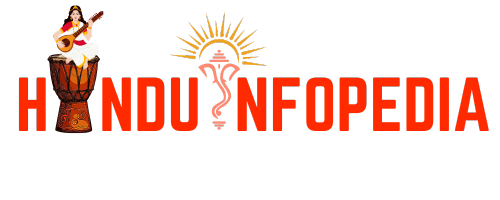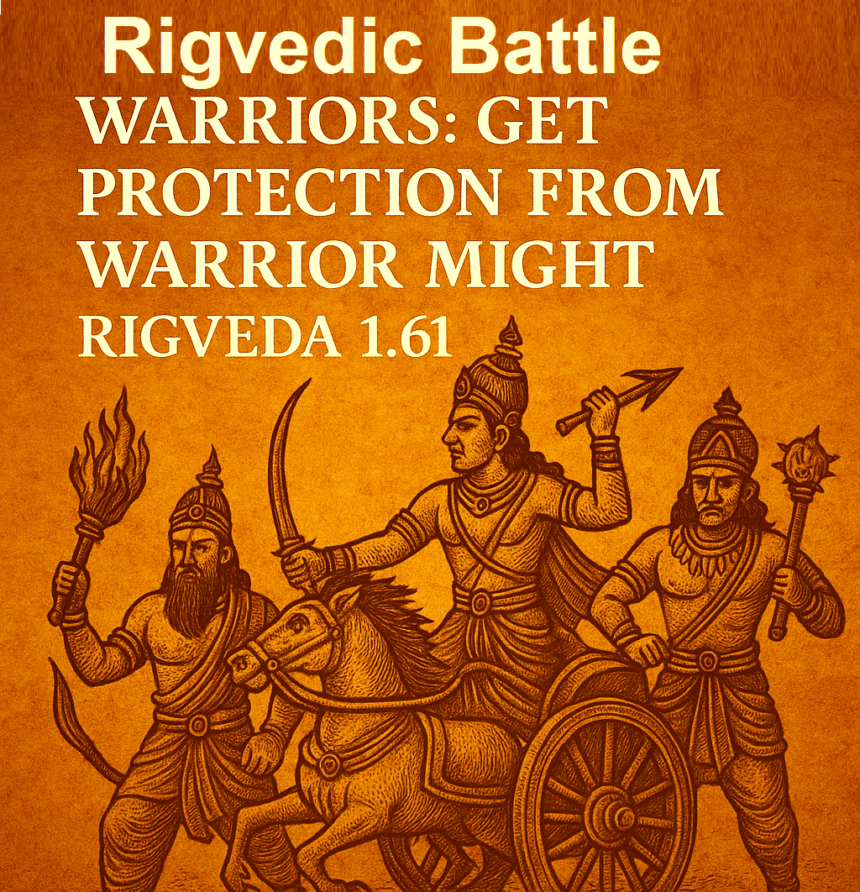Rigvedic Battle Warriors: Get Protection from Warrior Might Rigveda 1.61
Part XIII: Hymns of Safeguard
The Call of Rigvedic Battle Warriors
The Rigveda is not only a scripture of knowledge but a living armory of sound. Its verses are not passive recitations but calls of Rigvedic Battle Warriors—summons to cosmic allies, thunderous cries against enemies, and invocations of divine shields. In Sūktas 1.61 to 1.70, the ancients preserved a cluster of warrior chants that stand out as the most martial, the most protective, the most uncompromising in their demand for victory and safety.
In them we do not find gentle prayers for peace alone; we find the storm of Indra’s weapons, the roar of the Maruts, the fire-command of Agni. These are the chants of Rigvedic Battle Warriors—hymns of survival, conquest, and dharmic defense—echoes of a time when every sacred verse was wielded as a weapon.
Rigvedic Battle Warriors Show Protection Is Not Passive
To the Vedic seers, protection was never passive shielding. It meant facing the hostile—whether demons of chaos like Vṛtra, raiders who withheld the cows, or metaphysical forces of drought, darkness, and oppression. The gods are called not to console but to strike, smash, and scatter the powers of adharma.
- Indra, with his thunderbolt, is urged to cut Vṛtra apart “like a butcher cuts meat.”
- The Maruts are celebrated as youthful warriors, rushing in formation with weapons that terrify heaven and earth.
- Agni, far from being only hearth fire, is invoked as senāpati—army leader—whose arrows and blazing fury drive enemies into flight.
Rigvedic Battle Warriors in Rigveda 1.61.5–15: Indra the Fort-Destroyer
1.61.5
Devanāgarī (Samhitā):
अ॒स्मा इदु॒ सप्ति॑मिव श्रव॒स्येंद्रा॑या॒र्कं जु॒ह्वा॒३॒॑ समं॑जे ।
वी॒रं दा॒नौक॑सं वं॒दध्यै॑ पु॒रां गू॒र्तश्र॑वसं द॒र्माणं॑ ॥
Audio Track
Padapāṭha (IAST):
asmai it saptim iva śravasyendra-āya arkam juhvā sam añje |
vīram dāna-okasam vandadhyai purām gūrta-śravasam darmāṇam ||
Translation:
“To Indra I yoke the chant like a war-steed harnessed for glory. I praise the Hero, the giver of wealth, the demolisher of fortresses, famed as the destroyer of enemy strongholds.”
Commentary:
Here Indra is not invoked as a gentle god but as Purām-darmāṇaḥ—the breaker of fortified cities. The hymn itself becomes a battle horse, pulling the divine force into action.
1.61.6
Devanāgarī (Samhitā):
अ॒स्मा इदु॒ त्वष्टा॑ तक्ष॒द्वज्रं॒ स्वप॑स्तमं स्व॒र्यं१॒॑ रणा॑य ।
वृ॒त्रस्य॑ चिद्वि॒दद्येन॒ मर्म॑ तु॒जन्नीशा॑नस्तुज॒ता कि॑ये॒धाः ॥
Audio Track
Translation:
“For him the divine craftsman Tvaṣṭṛ forged the thunderbolt—heaven-born, perfect in power, fashioned for battle. With it Indra struck the vital core of Vṛtra, wielding the irresistible force.”
Commentary:
This is the archetypal weapon verse—the origin of the Vajra. The thunderbolt is not symbolic but the literal cosmic weapon, ensuring victory over the serpent of obstruction.
1.61.7
Devanāgarī (Samhitā):
अ॒स्येदु॑ मा॒तुः सव॑नेषु स॒द्यो म॒हः पि॒तुं प॑पि॒वांचार्वन्ना॑ ।
मु॒षा॒यद्विष्णुः॑ पच॒तं सही॑या॒न्विध्य॑द्वरा॒हं ति॒रो अद्रि॒मस्ता॑ ॥
Audio Track
Translation:
“In the pressings of his Mother he drank the Soma, the great draught of the Father. Mighty Viṣṇu, his ally, cooked the offering; together they pierced the Boar (Vṛtra) and hid him beneath the mountain.”
Commentary:
This verse shows Indra and Viṣṇu allied in combat. Vṛtra is described as a monstrous boar pierced through the rock—an image of primal violence and victory.
1.61.8
Devanāgarī (Samhitā):
अ॒स्मा इदु॒ ग्नाश्चि॑द्दे॒वप॑त्नी॒रिंद्रा॑या॒र्कम॑हि॒हत्य॑ ऊवुः ।
परि॒ द्यावा॑पृथि॒वी ज॑भ्र उ॒र्वी नास्य॒ ते म॑हि॒मानं॒ परि॑ ष्टः ॥
Audio Track
Translation:
“Even the goddesses, wives of the gods, sang the hymn for Indra in the slaying of the serpent. He seized heaven and earth wide apart, yet they could not encompass his greatness.”
Commentary:
This shows the universal acclaim of Indra’s battle—even the energies (deva-patnīḥ) join in his victory over the serpent of chaos.
1.61.9
Devanāgarī (Samhitā):
अ॒स्येदे॒व प्र रि॑रिचे महि॒त्वं दि॒वस्पृ॑थि॒व्याः पर्यं॒तरि॑क्षात् ।
स्व॒राळिंद्रो॒ दम॒ आ वि॒श्वगू॑र्तः स्व॒रिरम॑त्रो ववक्षे॒ रणा॑य ॥
Audio Track
Translation (summary):
“Indra’s greatness spread beyond heaven, earth, and mid-world. Self-sovereign, the strong, he advanced to battle, acclaimed by all.”
Commentary:
Indra’s might is not confined to a single battlefield. His greatness stretches beyond heaven, earth, and the mid-world, asserting sovereignty in all realms. By advancing to battle as svarāṭ (self-king), he becomes the archetype of cosmic order itself. This verse portrays protection as more than defense of a tribe—it is the rebalancing of creation, where Indra’s stride safeguards dharma on every plane.
1.61.10
Devanāgarī (Samhitā):
अ॒स्येदे॒व शव॑सा शु॒षंतं॒ वि वृ॑श्च॒द्वज्रे॑ण वृ॒त्रमिंद्रः॑ ।
गा न व्रा॒णा अ॒वनी॑रमुंचद॒भि श्रवो॑ दा॒वने॒ सचे॑ताः ॥
Audio Track
Translation (summary):
“By his might he clove the hissing Vṛtra with the thunderbolt. He loosed the pent-up waters like imprisoned cows, bringing wealth and inspired vision.”
Commentary:
This is the classic Vṛtra-slaying verse—Indra releases the waters, a mythic act of cosmic liberation that is also the archetype of defeating suppression.
1.61.11
Devanāgarī (Samhitā):
अ॒स्येदु॑ त्वे॒षसा॑ रंत॒ सिंध॑वः॒ परि॒ यद्वज्रे॑ण सी॒मय॑च्छत् ।
ई॒शा॒न॒कृद्दा॒शुषे॑ दश॒स्यंतु॒र्वीत॑ये गा॒धं तु॒र्वणिः॑ कः ॥
Audio Track
Translation (summary):
“The rivers rejoiced in his blazing might, when he smote Vṛtra with the thunderbolt. He made men kings, giving power to the giver, clearing paths for the quick.”
Commentary:
The rivers themselves rejoice at Indra’s strike, showing that even nature celebrates the fall of obstruction. His thunderbolt does not merely destroy—it expands pathways, makes fords, and creates new order. By “making men kings,” Indra grants sovereignty to those aligned with truth, ensuring that leadership itself is dharmic. This is not destruction for its own sake but empowerment of righteous rule, linking divine warfare to human governance.
1.61.12
Devanāgarī (Samhitā):
अ॒स्मा इदु॒ प्र भ॑रा॒ तूतु॑जानो वृ॒त्राय॒ वज्र॒मीशा॑नः किये॒धाः ।
गोर्न पर्व॒ वि र॑दा तिर॒श्चेष्य॒न्नर्णां॑स्य॒पां च॒रध्यै॑ ॥
Audio Track
Translation (summary):
“Hasten, O Lord, hurl the thunderbolt against Vṛtra. Cleave him as a joint of a cow; let the floods of water run free.”
Commentary:
This verse is as hardcore as it gets—direct command to Indra to slaughter Vṛtra like butchered cattle. Protection here is not passive: it is annihilation of the enemy.
1.61.13
Devanāgarī (Samhitā):
अ॒स्येदु॒ प्र ब्रू॑हि पू॒र्व्याणि॑ तु॒रस्य॒ कर्मा॑णि॒ नव्य॑ उ॒क्थैः ।
यु॒धे यदि॑ष्णा॒न आयु॑धान्यृघा॒यमा॑णो निरि॒णाति॒ शत्रू॑न् ॥
Audio Track
Translation (summary):
“Proclaim again the ancient deeds of the swift one, the hurler of weapons, who in battle casts down his foes.”
Commentary:
This verse urges the singer to retell Indra’s ancient deeds with fresh utterance—nāvya ukthaiḥ. The act of remembering is itself a weapon: by recalling Indra’s victories, the warrior-spirit is invoked anew. Indra is shown as ever-ready, hurling weapons, driving out enemies again and again. Protection here is not just memory—it is reenactment, where the spoken word reactivates divine force in the present struggle.
1.61.14
Devanāgarī (Samhitā):
अ॒स्येदु॑ भि॒या गि॒रय॑श्च दृ॒ळ्हा द्यावा॑ च॒ भूमा॑ ज॒नुष॑स्तुजेते ।
उपो॑ वे॒नस्य॒ जोगु॑वान ओ॒णिं स॒द्यो भु॑वद्वी॒र्या॑य नो॒धाः ॥
Audio Track
Translation (summary):
“At his birth even mountains trembled, and heaven and earth shook. Nodha’s hymn invoked his power, and at once he grew in heroic might.”
Commentary:
Indra’s very existence terrifies creation—his birth is a seismic event, shaking even mountains. A verse of raw divine intimidation.
1.61.15
Devanāgarī (Samhitā):
अ॒स्मा इदु॒ त्यदनु॑ दाय्येषा॒मेको॒ यद्व॒व्ने भूरे॒रीशा॑नः ।
प्रैत॑शं॒ सूर्ये॑ पस्पृधा॒नं सौव॑श्व्ये॒ सुष्वि॑माव॒दिंद्रः॑ ॥
Audio Track
Translation (summary):
“To him was given the White Horse of the Sun. Indra, the lord of wealth, pressed the Soma and raced in rivalry with the Sun.”
Commentary:
This verse links Indra’s battle-energy with solar power—a horse-race with the Sun itself, signifying limitless might and speed.
Rigvedic Battle Warriors as Eternal Shields for Dharmic Struggle
What makes these hymns timeless is not only their historical imagery but their eternal role. The threats have changed faces across ages—once as droughts and asuras, later as invaders and colonizers, today as ideological erasures and cultural battles. But the essence remains: dharma must be protected, and that requires force, both spiritual and martial.
The Rigveda does not ask us to be timid; it commands us to be warriors with sound, invoking divine allies as shields and weapons.
Why Rigvedic Battle Warriors Matter Today
These hymns are not relics. They are reminders that protection requires will. In times when cultural identities are threatened, when narratives attempt to dissolve civilizations, the Vedic answer is clear:
- Invoke strength, not surrender.
- Sing the battle Hymns, not lullabies.
- Stand in the storm with Indra, the Maruts, and Agni.
The Rigvedic Battle Warriors are a call to courage—a reminder that to be Hindu is to inherit not only peace but power.
Credits
Audio Clips: By Sri Shyama Sundara Sharma and Sri Satya Krishna Bhatta. Recorded by © 2012 Sriranga Digital Software Technologies Pvt. Ltd. [Credit: https://sri-aurobindo.co.in/ Cut using https://mp3cut.net/]
Verse Texts: https://sri-aurobindo.co.in/
Watch relevant Videos
Feature Image: Click here to view the image.
Watch the Videos
Glossary of Terms
-
Rigveda: The oldest of the four Vedas, a collection of over a thousand hymns composed in ancient Sanskrit.
-
Sūkta: A hymn or section within the Rigveda, composed of multiple verses dedicated to a deity.
-
Vṛtra: A serpent-demon in Vedic mythology who obstructs the waters; slain by Indra with his thunderbolt.
-
Vajra: The thunderbolt weapon forged by Tvaṣṭṛ for Indra; symbolizes irresistible force and divine power.
-
Tvaṣṭṛ: The divine craftsman in Vedic texts, maker of the Vajra used to destroy Vṛtra.
-
Maruts: Storm deities in the Rigveda, depicted as youthful warriors rushing in formation with weapons.
-
Agni: The Vedic fire-god, invoked both as hearth-fire and as senāpati (army leader) in battle contexts.
-
Senāpati: A Sanskrit term meaning “army leader” or commander, here used for Agni’s role in protection.
-
Purām-darmāṇaḥ: An epithet of Indra in the Rigveda meaning “breaker of forts” or destroyer of strongholds.
-
Nodha: A Vedic seer associated with hymns to Indra, credited in Rigveda 1.61.
-
Svar: The heavenly realm of light; often won by hymns and divine aid in Rigvedic verses.
-
Asura: In early Vedic texts, beings of power, often antagonistic to the gods and linked to adharma.
#Rigveda #Indra #Vajra #BattleHymns #HinduinfoPedia
#HymnsofSafeguard
Previous Blogs of the Series
- https://hinduinfopedia.org/civilization-under-siege-why-hindu-communities-face-an-existential-crisis/
- https://hinduinfopedia.org/crisis-documented-mathematical-evidence-of-systematic-hindu-elimination/
- https://hinduinfopedia.org/vedic-defense-mantras-rigvedas-protection-against-threats/
- https://hinduinfopedia.org/agni-suktas-for-protection-invoking-divine-fire-against-adharmic-forces/
- https://hinduinfopedia.org/indra-suktas-for-victory-invoking-the-divine-warrior-against-overwhelming-odds/
- https://hinduinfopedia.org/hymns-of-safeguard-an-ancient-armory-for-modern-crisis/
- https://hinduinfopedia.org/ashvini-kumar-suktas-for-divine-rescue-and-healing/
- https://hinduinfopedia.org/rigvedic-hymns-a-deeper-look-at-divine-protection/
- https://hinduinfopedia.org/vedic-defense-through-rigveda-richas-a-deeper-look-at-divine-protection/
- https://hinduinfopedia.org/mantras-for-defense-hardcore-rigvedic-protection-against-spiritual-disturbances/
- https://hinduinfopedia.org/vedic-invocations-of-power-indras-thunderbolt-and-the-eternal-hymns-of-safeguard/
- https://hinduinfopedia.org/rigvedic-battle-chants-hymns-of-safeguard-from-rigveda-1-52/
Later Blogs



Leave a Reply